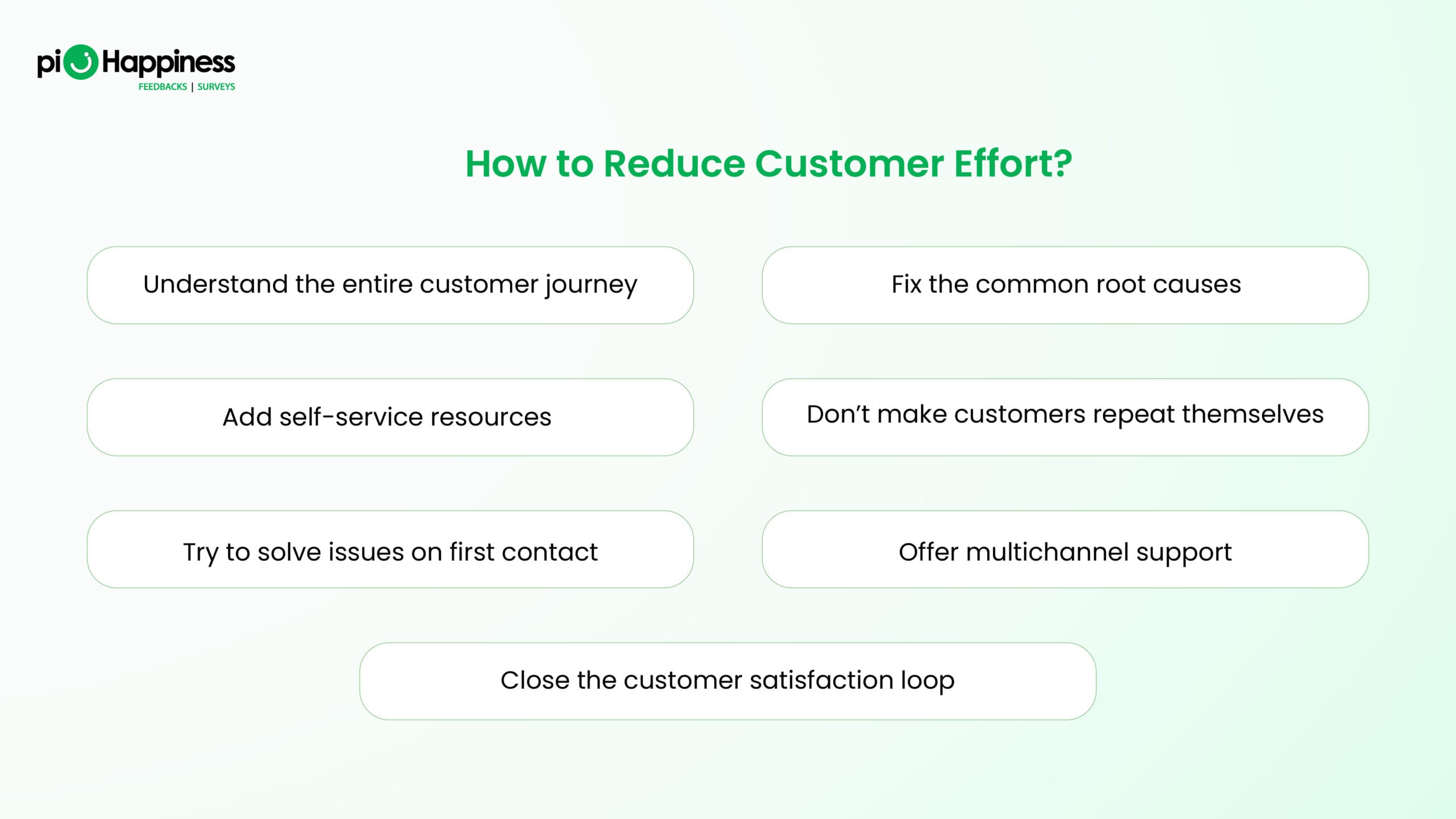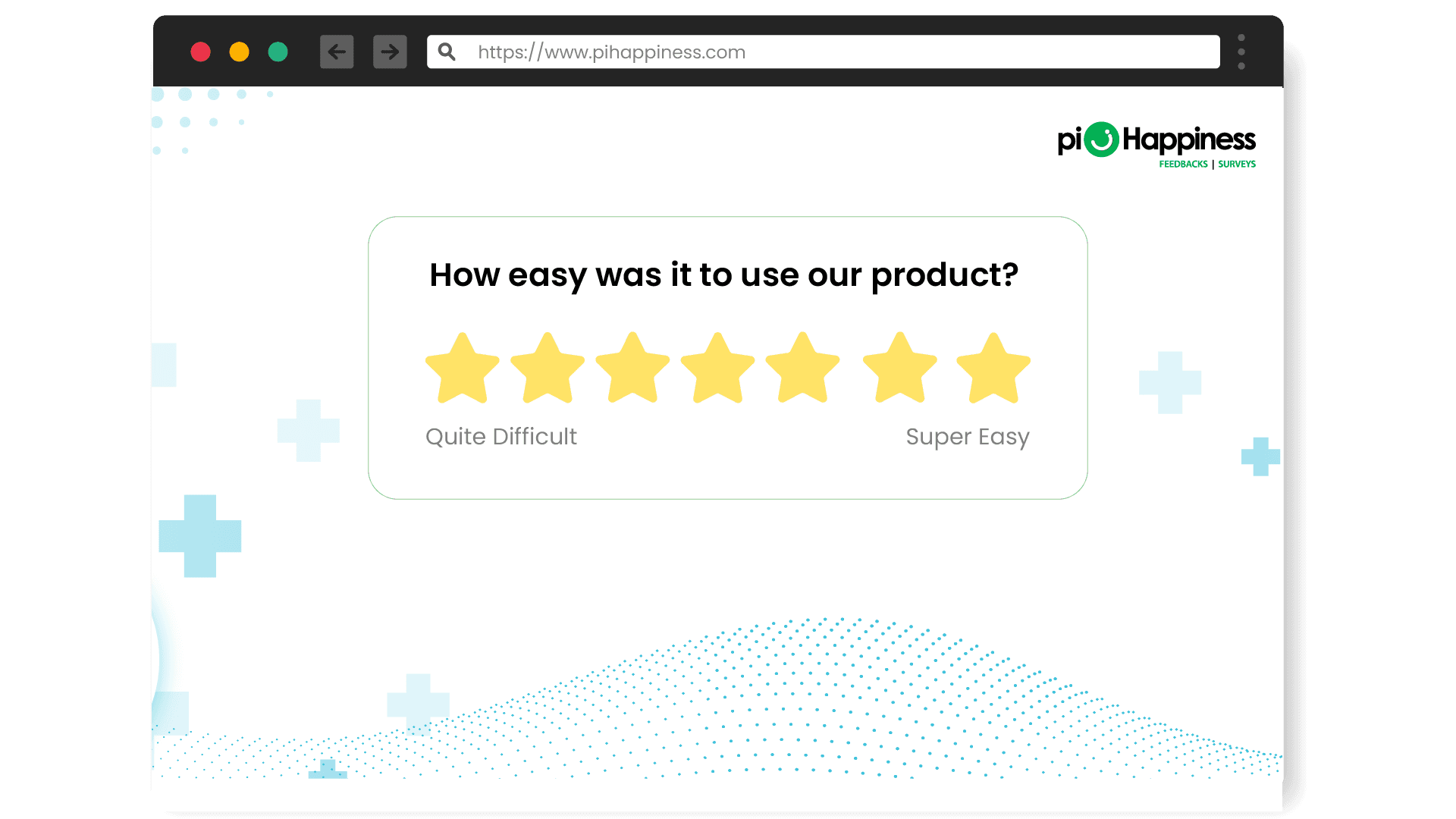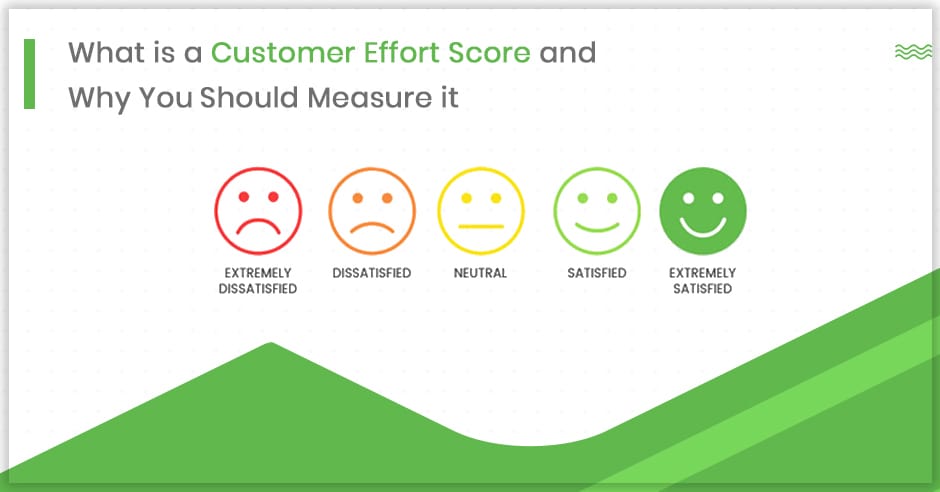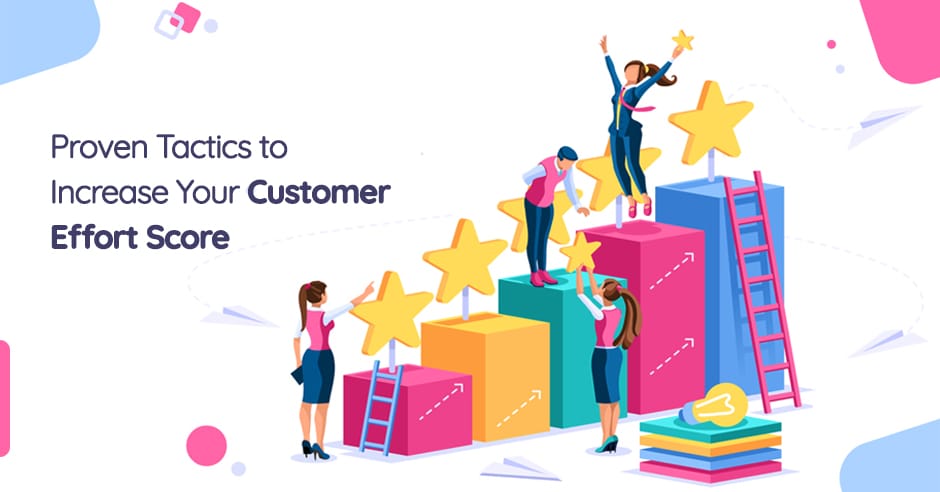What is customer effort score?
CES stands for Customer Effort Score. It is a customer experience metric like NPS® and CSAT. CES measures how much effort customers put in to get their issues resolved or achieve their goals with a product or service.
In simple words, CES is about the “ease of use” of a product, service, or any customer interaction.
CES helps businesses understand how smooth or difficult a customer’s experience is. When customers don’t have to work hard to get what they need, they’re more likely to stay loyal and recommend the company.
Here are a few examples of customer effort score survey questions:
- How easy was it to use our website?
- On a scale of 1 to 5, how much effort did you put in to use our product?
- How easy was using our service so far?
- On a scale of 1 to 7, please rate the level of effort it took to use “X” feature.
- To what extent do you agree with this statement: Your customer service team made it easy to resolve my issue.
- Were the instructions easy to follow?
How to measure customer effort score?
Now that you know what CES is, let’s see how to measure customer effort score:
Step 1: Analyze customer journeys and find pain points
Start by analyzing your customers’ journey—from their first interaction with your brand to point Z. Look for points where they experience friction, delays, or frustration. Are there unnecessary steps in your checkout process? Is customer support difficult to get in touch with? Identifying these roadblocks helps you understand where customer effort is highest.
Step 2: Go through reviews and support tickets
Customer reviews and support tickets are valuable sources of insight. Go through online reviews across different platforms to find recurring complaints about complexity or frustration. Similarly, analyze support tickets to see which issues customers frequently report. Are they struggling with a specific feature? Do they repeatedly ask for help with the same process? These patterns highlight areas that require improvement.
Step 3: Send CES surveys to collect feedback
Here is the best way to measure customer effort score – send CES surveys to your customers. CES surveys typically ask a simple question, such as:
“How easy was it for you to complete your task?”
Customers rate their experience on a scale (e.g., from “Very Easy” to “Very Difficult”). This will give you quantifiable data on how much effort they had to put in. Distribute these surveys after key interactions, such as a purchase, a support call, or using a new feature, to capture real-time feedback.
Step 4: Act on feedback and optimize the customer experience
Customer effort is one of the best customer satisfaction metrics. That is why; after gathering and grouping the insights, it is time to act on the feedback. If customers report that navigating your website is frustrating, consider simplifying the layout and improving search functionality so that customers do not have to put in much effort.
If they struggle with onboarding, provide better tutorials or self-service options. The goal is to reduce effort at every stage, leading to higher satisfaction, increased loyalty, and ultimately, better retention. By continuously refining your processes based on CES insights, you can create a smoother, more effortless experience for your customers—boosting both satisfaction and long-term brand success.
Why is it important to reduce customer effort?
Customer effort impacts the overall customer experience. When interacting with a business, customers expect convenience, speed, and efficiency. The easier it is for them to complete a task—whether it’s making a purchase or contacting the support team—the more satisfied they will be. On the other hand, when customer effort is high, it can lead to frustration, dissatisfaction, and ultimately loss of business.
Here are a few reasons why reducing customer effort score is considered essential for businesses:
High effort leads to dissatisfaction
If customers have to jump through hoops just to get a simple task done—such as finding information, completing a transaction, or getting support—their frustration levels rise.
A complicated checkout process, long wait times for support, or unclear instructions can all contribute to a negative experience. Dissatisfied customers are not just less likely to return, but they may also vent their frustration publicly, damaging your brand’s reputation.
Negative reviews can hurt brand reputation
Frustrated customers often express their dissatisfaction through online reviews and social media. A single negative review can influence potential buyers, but a pattern of complaints about difficulty or inconvenience can significantly harm your brand’s credibility.
Did you know that around 95% of customers go through online feedback before making purchasing decisions? Poor ratings due to high customer effort can deter new customers from even considering your business, making it harder to acquire new users and grow your customer base.
Increased customer churn and low retention
At present, customers have countless options at their fingertips, and they won’t hesitate to switch to a competitor that offers a smoother, more effortless experience.
If a competitor makes it easier to book an appointment, get a refund, or contact customer service, customers are more likely to choose them over you. High customer effort leads to churn, meaning existing customers stop doing business with you, which in turn lowers retention rates.
Lower loyalty and reduced lifetime value
Customer effort is a reliable customer loyalty measurement. Customer loyalty is built on trust, ease, and consistency. If customers repeatedly face obstacles when interacting with your brand, they won’t stick around for long. On the other hand, when customers find it easy to do business with you, they are more likely to return, make repeat purchases, and even advocate for your brand through word-of-mouth. Low effort experiences contribute to higher customer lifetime value (CLV), ensuring long-term profitability.
Direct impact on revenue and business growth
High customer effort score doesn’t just frustrate users—it directly affects a company’s bottom line. When customers leave due to difficult experiences, businesses lose recurring revenue. Moreover, acquiring new customers is far more expensive than retaining existing ones.
If negative reviews drive potential customers away and existing customers churn, business growth slows down. On the flip side, reducing customer effort enhances satisfaction, strengthens customer relationships, and drives higher revenue through repeat business and positive referrals.
How to reduce customer effort?
Let’s check out some of the best ways to reduce customer effort score:
Understand the entire customer journey
The first step in reducing customer effort is to understand the entire customer journey. This means analyzing every interaction a customer has with your brand, from initial awareness to post-purchase support. By doing this, you can:
- Identify key touchpoints where customers engage with your business.
- Spot areas where customers face delays, confusion, or frustration.
- Understand what customers need at each stage of their journey and proactively address potential roadblocks.
A detailed customer journey map helps you see things from the customer’s perspective, making it easier to design a smoother and more efficient experience.
Fix the common root causes
While analyzing customer journeys, you’ll likely find recurring issues that cause friction—these are common pain points where customers exert unnecessary effort. Some examples include:
- Complicated checkout processes that require multiple steps.
- Difficult-to-navigate websites with poor search functionality.
- Long wait times for customer support or being transferred multiple times.
- Unclear product/service instructions that lead to confusion.
Once you identify these friction points, it is best to fix them on priority. Streamline processes, remove unnecessary steps, and optimize interactions to make everything as effortless as possible.
Add self-service resources
Customers don’t always want to contact support for minor issues. Providing self-service options can drastically reduce the effort they need to put in while also decreasing the burden on your support team. Here’s what you can offer:
- FAQs and knowledge base: A well-structured knowledge center with FAQs, articles, troubleshooting guides, and tutorials can help customers quickly find answers to common questions.
- AI-powered chatbots: Chatbots can provide instant support by answering frequently asked questions, guiding users through processes, and escalating complex issues to human agents when necessary.
- How-to videos and step-by-step guides: Some customers prefer visual instructions over reading long articles. Providing video tutorials can make it easier for them to resolve issues independently.
Ensure these self-service tools are easy to find, clearly structured, and regularly updated to remain useful.
Avoid asking customers to repeat their problems
One thing that frustrates customers is having to explain their issues multiple times. Imagine calling customer support, explaining the problem in detail, and then being transferred to another agent—only to be asked to repeat everything again. This not only wastes time but also increases frustration.
To prevent this:
- Use CRM systems that store customer interactions, so agents have full context before speaking to the customer.
- Ensure seamless internal communication within customer support teams to avoid redundant questions.
- Implement ticketing systems that track issue history, so customers don’t have to start from scratch when they switch channels (e.g., from chat to phone support).
Reducing repetition makes interactions smoother, improves efficiency, and significantly enhances the customer experience.
Try to solve issues on first contact
The best way to reduce customer effort score is to solve issues during the first interaction—whether through phone, chat, email, or social media. First Call Resolution or First Contact Resolution (FCR) ensures that customers don’t have to reach out multiple times to get their issues fixed.
To improve FCR rates:
- Train customer service agents to handle a wide range of issues effectively.
- Provide them with easy access to necessary tools, knowledge bases, and internal support.
- Encourage proactive problem-solving, ensuring agents go beyond quick fixes to resolve underlying concerns.
A high FCR rate directly reduces customer effort, increases satisfaction, and boosts brand loyalty.
Offer multichannel support
Customers have different preferences when it comes to communication. Some may prefer phone calls, while others find live chat or social media more convenient.
To reduce customer effort, provide multiple support channels and let customers choose the one that suits them best. Popular support channels include live chat, phone support, email support, social media support, AI-powered self-service portals, and more.
Close the customer satisfaction closure loop
Reducing customer effort is an ongoing process, and one of the best ways to measure progress is through customer feedback. However, simply collecting feedback isn’t enough—you need to act on it.
Send CES surveys to assess how easy it was for customers to complete a task. Regularly analyze feedback from support interactions, online reviews, and surveys to identify new friction points. Most importantly, follow up with customers to ensure that their concerns have been addressed and that they are satisfied with the resolution.
By closing the feedback loop, you demonstrate that you value your customers’ time and are trying to improve their experience.
Summary: Reduce customer effort and improve CX with piHappiness
Reducing customer effort isn’t just about improving convenience—it’s about creating a frictionless and enjoyable experience that keeps customers coming back. By understanding their journey, addressing pain points, providing self-service options, streamlining support, and continuously optimizing interactions, you can make it easier for customers to engage with your brand.
If you are looking for a survey platform to create CES surveys, piHappiness is here to help. We are one of the leading customer experience platforms where you can create and send surveys and also analyze the results and the sentiments behind the feedback. Book a demo here to see how piHappiness works.









